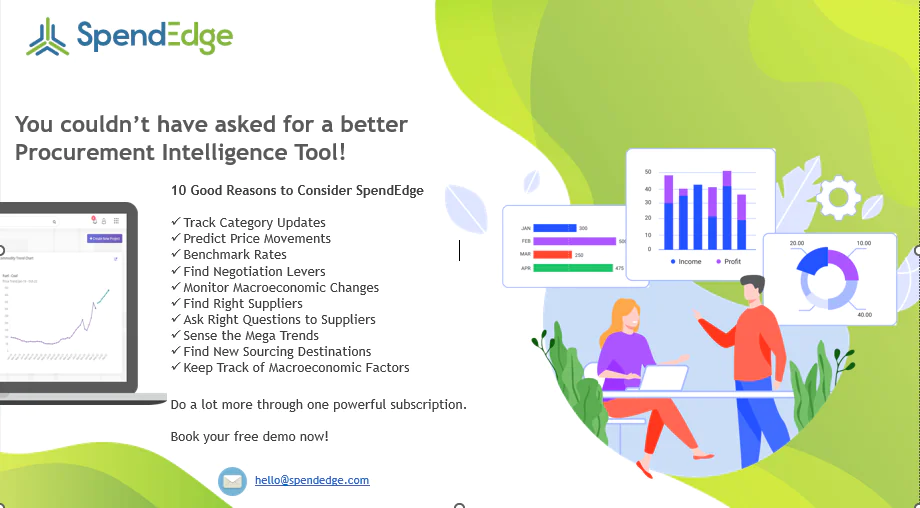Category overview
Over the past five years, the electronic components industry has experienced substantial growth, driven by the escalating necessity of electronics in the digital age. This expansion is propelled by ongoing advancements in consumer, automotive, industrial, and defense electronics, as well as the increasing opportunities within the upstream supply chain. These trends have catalyzed innovation and technological advancements in design, enhancing the industry’s dynamic nature.
Challenges faced by the electronic components manufacturing industry in supply chain
The electronic components manufacturing industry faces a multitude of supply chain challenges that can significantly impact production and profitability. The following are the major challenges faced by the industry:

Recent trends in the supply chain
| Trend | Impact | Way forward |
| Digital transformation | Enhances supply chain visibility and traceability, mitigates risks, and ensures compliance | Investing in advanced technologies such as IoT, AI, and blockchain |
| Sustainability focus | Reduces environmental impact and adheres to stringent regulatory requirements | Adopting sustainable practices and improving eco-friendly manufacturing processes |
| Geopolitical stability | Anticipates and mitigates potential supply chain disruptions of essential components | Monitoring geopolitical developments and creating contingency plans |
| Supplier diversification | Minimizes risks associated with dependency on single suppliers | Diversifying the supplier base and establishing strategic partnerships |
| Cybersecurity measures | Protect against data breaches and cyber threats as the industry becomes more digitized | Implementing robust cybersecurity measures and protocols |
By adopting above trends, electronic components manufacturers aim to reduce supply chain risks, cut costs, and improve overall operational efficiency. Supply chain risk analysis solutions play a crucial role in this process, enabling companies to navigate complexities and maintain competitiveness in a rapidly evolving market.
The procurement pain point and insights offered
A leading electronic components manufacturer aimed to gain a comprehensive understanding of their current supply chain structure, recent supply trends, and future forecasts. This manufacturer sought to assess supply chain risks and evaluate profitability across their entire supply chain. Furthermore, they required strategic recommendations to reduce significant expenditure areas, particularly across their office locations, through a detailed supply chain risk analysis engagement.
Key insights and recommendations offered include:
- Supply chain structure analysis: It helped in assessing the relationships and interactions between various entities, such as suppliers, manufacturers, distributors, and retailers. It identifies inefficiencies, bottlenecks, vulnerabilities, and offers opportunities for improvement within the supply chain
- Trends and forecasts: It analyzed recent supply trends and generated accurate forecasts that enabled the manufacturer to anticipate changes in demand, adjust inventory levels accordingly, and align procurement strategies with market conditions, thereby staying ahead of market dynamics
- Risk assessment: Conducted a thorough assessment of risks associated with the supply chain, including geopolitical risks, supplier reliability, and potential disruptions. It helped in developing robust mitigation strategies and ensuring a more resilient and secure supply chain
- Profitability evaluation: Evaluated profitability across the supply chain to identify cost drivers and opportunities for margin improvement. It optimized procurement costs, reduced waste, and enhanced overall financial performance, leading to improved profitability
- Cost reduction recommendations: Provided specific recommendations to reduce major expenditure areas, particularly across office locations, including strategies for strategic sourcing, procurement optimization, and vendor management. Implementing these recommendations resulted in significant cost savings and more efficient operations
- Sustainability and compliance: Conducted a thorough analysis of current operations to assess compliance with international standards and regulations. Implemented systems to improve traceability across the supply chain, enabling better monitoring of materials and processes
- Technology integration: Explored the integration of advanced technologies such as AI, IoT, and blockchain. Leveraging these technologies enhanced supply chain visibility, traceability, and efficiency, enabling real-time monitoring and more informed decision-making
To address the specific category requirements of the client, the supply chain analysts at SpendEdge implemented a comprehensive two-step research methodology. This approach combined primary and secondary research with qualitative and quantitative data collection procedures to effectively tackle the client’s business challenges.
Throughout the engagement, the client used a detailed supply chain vulnerability map to enumerate and mitigate risks, highlighting weak points, and enabling targeted risk management strategies. The analysts recommended a business-process model to identify various categories of vulnerability, providing a structured framework for assessing and addressing risks from supplier reliability to geopolitical factors. The engagement also facilitated a broader impact assessment on the global supply chain, helping the client understand the ripple effects of disruptions and implement measures to enhance resilience.
Business outcome
The supply chain risk analysis engagement delivered significant benefits for the client, including substantial risk reduction and cost savings across the value chain. This comprehensive analysis offered clear and actionable insights into major spending areas, particularly across office locations. By reducing risks, cutting costs, and providing detailed spending insights, the client enhanced their operational efficiency and strategic decision-making. This approach not only addressed immediate challenges but also positioned the client for long-term success and resilience in the competitive electronic components industry.





